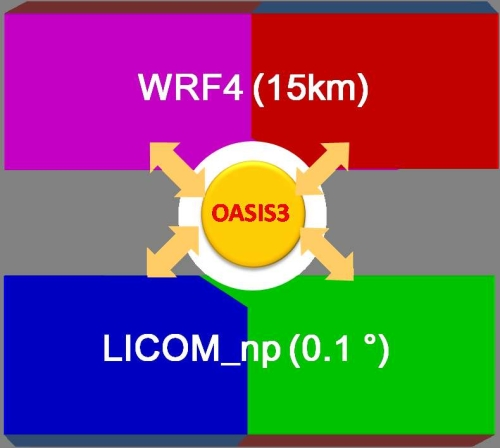Aug 4 2020
Until now, researchers have extensively used regional climate models (RCMs) that include high-resolution topography and surface characteristics for applications spanning from process studies to climate change and paleoclimate simulations.
 Model framework. Image Credit: ZOU Liwei.
Model framework. Image Credit: ZOU Liwei.
Regional coupled modeling or regional earth system modeling is one of the frontiers of regional climate modeling, and it is crucial to couple the ocean component in RCMs to advance regional earth system models.
Dr ZOU Liwei at the Institute of Atmospheric Physics (IAP) of the Chinese Academy of Sciences and his colleagues from Nanjing University have now described their newly developed regional ocean-atmosphere coupled model in Advances of Atmospheric Sciences.
We coupled the recently released WRF4.0 model with a North Pacific Ocean model (LICOM_np) developed at the Institute of Atmospheric Physics through the OASIS3.0 coupler. The horizontal resolution was set to 15 km in WRF4.0, while it was 0.1° in LICOM_np.
Dr ZOU Liwei, Professor, Institute of Atmospheric Physics, Chinese Academy of Sciences
The researchers compared the performance of the regional coupled model, named WRF4_LICOM, with that of another regional coupled model, called RegCM4_LICOM, which was a coupling between the regional climate model, termed version 4 (RegCM4), and LICOM_np. The focus of the comparison was on the 2005 western North Pacific (WNP) summer monsoon rainfall. The findings illustrate that the developed model, known as WRF4-LICOM, showed credible performance over the WNP.
In the paper, the team reports that RegCM4_LICOM showed smaller biases in its simulation of the averaged June-July-August sea surface temperature (SST) and rainfall, and WRF4_LICOM was found to better quantify the TC (tropical cyclone) intensity, the percentages of contribution of rainfall initiated by TCs to the total rainfall, and the diurnal cycle of rainfall and stratiform percentages, particularly across the land area.
The variations in rainfall simulated by the two models were partly attributed to the behaviors in the simulated western North Pacific subtropical high (WNPSH).
The team proposed that the stronger WNPSH in WRF4_LICOM or the weaker WNPSH in RegCM4_LICOM was induced by the overvalued or undervalued diabatic heating, respectively, which reached the maximum at around 450 hPa across the region around the Philippines, in relation to different condensation-radiation processes.
Coupling WRF4 with LIOCM is a crucial step towards the development of the next generation of regional earth system model at the Chinese Academy of Science, and our intercomparison provides a useful reference for tuning the upcoming regional earth system model in the future.
Dr ZOU Liwei, Professor, Institute of Atmospheric Physics, Chinese Academy of Sciences
Moreover, the cumulative credible performance of WRF4_LICOM denotes that such models can be employed for an extensive range of applications, like the dynamical downscaling of simulations and projections synthesized by global models.
Journal Reference
Zou, L., et al. (2020) Introduction to the Regional Coupled Model WRF4-LICOM: Performance and Model Intercomparison over the Western North Pacific. Advances in Atmospheric Sciences. doi.org/10.1007/s00376-020-9268-6.
Source: http://english.cas.cn/